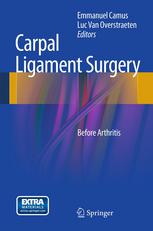

Most ebook files are in PDF format, so you can easily read them using various software such as Foxit Reader or directly on the Google Chrome browser.
Some ebook files are released by publishers in other formats such as .awz, .mobi, .epub, .fb2, etc. You may need to install specific software to read these formats on mobile/PC, such as Calibre.
Please read the tutorial at this link: https://ebookbell.com/faq
We offer FREE conversion to the popular formats you request; however, this may take some time. Therefore, right after payment, please email us, and we will try to provide the service as quickly as possible.
For some exceptional file formats or broken links (if any), please refrain from opening any disputes. Instead, email us first, and we will try to assist within a maximum of 6 hours.
EbookBell Team

0.0
0 reviewsIt has by now been established that carpal ligamentary lesions may lead to instability and ultimately to carpal arthritis. However, the variety of anatomopathological classifications and the multiplicity of surgical repair techniques reflect the difficulty of grasping this ligamentary pathology.
Clinical analysis and traditional investigation techniques must successfully address the complexity of the wrist, which is largely due to the number of synchronized bones involved in every movement of the hand. The clinical analysis of the wrist is insufficient to precisely measure the mobility of each carpal bone, making paraclinical examinations also significant for clinical diagnosis. The tools available today range from X-rays to arthroscopy, including arthroCTscans and soon MRI. As for repair techniques, their diversity must not hide the fact that a biomechanical and physiological principle is involved and must be identified.
This book presents the findings of an expert group in the field of wrist pathology. It seeks to analyze, understand, explain and make comprehensible, if not obvious, the reflections that each practitioner should employ during the diagnosis and treatment of carpal ligamentary lesions. The focus is consciously not on degenerative carpal pathology, which usually enjoys more visibility. We hope that readers will benefit from the fact that fragmented pieces of knowledge are gathered in a single work, that they will find in this initial synthesis an inspiration to rethink a difficult and sometimes thankless surgery and to further the surgical advances of the 21st century.